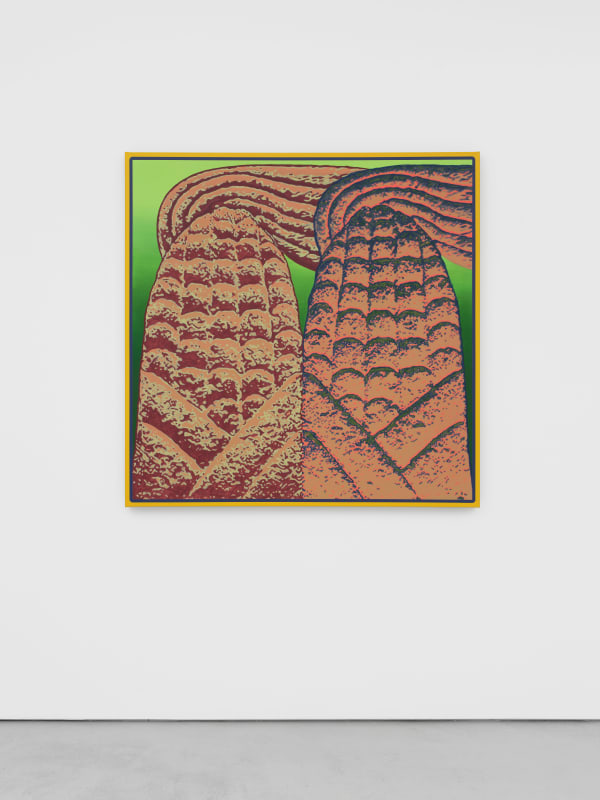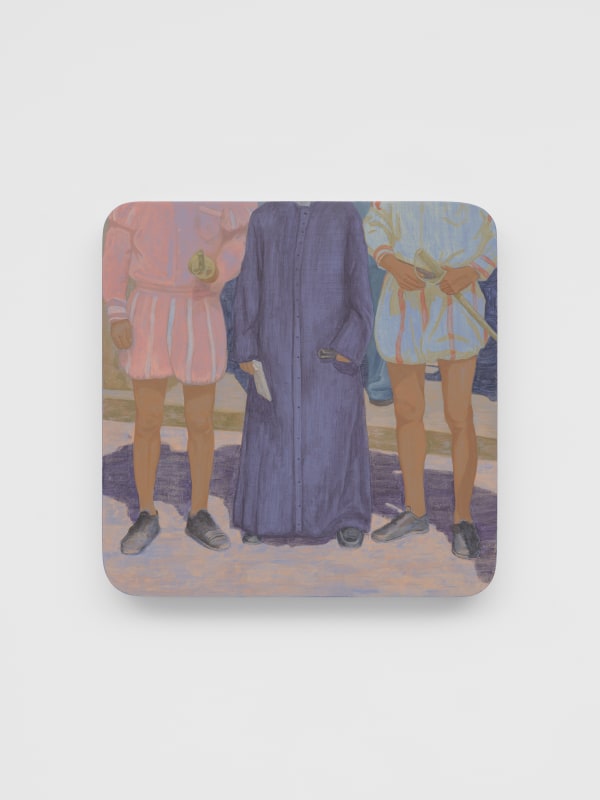Claudia Martínez Garay: Borrowed Air
GRIMM is pleased to present Borrowed Air, a solo exhibition of new work by Claudia Martínez Garay (b. 1983, Ayacucho, Peru) on view at the London gallery from January 9 to February 22, 2025.
After her critically acclaimed solo exhibitions at Nottingham Contemporary and Dundee Contemporary Arts in 2024, GRIMM presents Borrowed Air, Claudia Martínez Garay’s third solo exhibition in the UK. This new body of work illustrates what Martínez Garay calls "moments of rupture" – the instances in which European modernity collides with Andean cosmovisions – moments from which there is a before and an after. The artist uses printmaking, etching and painting, media in which brown bodies have historically been underrepresented, to create lucid enunciations from an Andean perspective. The result is a series of works of political and emotional heft that encourage the viewer to think from the other side of the colonial divide.
In Intrusos en sus tierras (2024), Martínez Garay borrows from the aesthetics of state-sanctioned school textbooks, a tool for nationalist propaganda, to challenge the supposed objectivity of official accounts of history. The contrast between the colours brown and white is a recurring motif in this series – this chromatic strategy highlights the presence of the brown body in the gallery space.
In one print, a white hand draws Tupac Amaru II, leader of an Indigenous uprising against the Spanish – the artist questions which perspective his story is told from; how visual language feeds the imaginary of a country and asks whether visual tools can be employed to challenge the dominant narratives of history. Another print from this series depicts two brown boys with a white mask separating them. The work at once evokes the syncretic tradition of Andean carnival and Franz Fanon’s gut-wrenching descriptions of the colonial wound in books like Black Skin, White Masks (1952) where he declares that whiteness is the only destiny for the subaltern body.
The first, and perhaps most important, work in this series depicts a leather shoe (a symbol of urbanity, of ‘civilisation’) stamping on a quena, a flute of great importance in Andean culture. The work directly references the epistemicide enacted by the Spanish during their colonial conquests – the silencing of Indigenous forms of knowing and being with the Earth; the silence of modesty and servitude into which many Indigenous people were forced. Silence, however, can also be a refusal: a refusal to be translated, to be read through Western anthropological frames of reference. Silence, as the writer and curator Pablo José Ramírez notes, is not the absence of discourse or meaning, but ‘the absence of a discursive explanatory regime’1.
In her new series of paintings, Martínez Garay pairs the image down to its most basic compositional elements, communicating at the most fundamental and direct level. In these paintings, silence and space, or the absence of certain compositional elements, speak as much as the compositional elements that are present. Despite their economic language, the paintings remain striking, legible and brimming with energy. The silent scream of Los Eternos, like the silence of water the moment before it reaches a furious boil, encapsulates the paintings’ spiritedness.
In this new body of work we are witness to Martínez Garay attempting to make sense of our current political tangle. Altar para Marina takes iconography from contemporary culture as well as historical material found in books and archives. From these images, the artist creates small, intimate drawings which are amplified and printedonto metal, creating a composition in which the origin of each image is unclear. A drawn rope ties the composition together – an attempt to contain or create meaning from a diverse range of symbols, an allusion to our present condition’s entanglement with our fraught colonial past.
This exhibition is further demonstration of Martínez Garay’s versatility and dexterity as an artist – experimenting with diverse media and pushing the boundaries of her print and painting practice whilst maintaining the political power that makes her work increasingly urgent.
– Diego Chocano, 2024
1 Pablo José Ramírez, An Instrument That Had No History
Raven Chacon in conversation with Pablo José Ramírez, 2024, Mousse Magazine
About the artist
Claudia Martínez Garay (b. 1983 in Ayacucho, Peru) studied printmaking at the Pontificia Universidad Católica of Peru (PE) and was a resident at the Rijksakademie van Beeldende Kunsten in Amsterdam (NL) from 2016 to 2017.
Recent solo exhibitions include: Every Seed is awakened, Dundee Contemporary Arts (UK); Wakchakuna / We Who Share Everything and Nothing, Nottingham Contemporary (UK) in 2024; Ghost Kingdom, GRIMM, New York, NY (US) and Ayataki, Artpace, San Antonio, TX (US) in 2022; Caminos de Liberación, GRIMM, Amsterdam (NL) in 2021; Ten Thousand Things, Sifang Art Museum, Nanjing (CN) in 2020.
Selected group exhibitions include: Devenir Tierra, 80m2 Livia Benavides, Lima (PE); Sediment Spirit, Sainsbury Centre for Visual Arts, Norwich (UK); Vessel and Veil, David Castillo Gallery, Miami, FL (US); Echoes of Our Stories, Quinta do Quetzal, Vidigueira (PT); The Measure of the World, RADIUS, Delft (NL) in 2023; Cassandra's Complex, basis e.v., Frankfurt (DE); Who Tells a Tale Adds a Tail: Latin America and Contemporary Art, Denver Art Museum, CO (US); Museum Arnhem, Arnhem (NL) in 2022; No Linear Fucking Time, B.A.K., basis voor actuele kunst, Utrecht (NL); All Eyes | We are the collection, AkzoNobel Art Foundation, Amsterdam (NL); Plural Domains, Harn Museum of Art, Gainesville, FL (US); Fragments of Sphere, Project Space on the Inside, Amsterdam (NL) in 2021; 1 Million Roses for Angela Davis, Kunsthalle im Lipsiusbau, Dresden (DE); The Faculty of Sensing: Anton Wilhelm Amo, Kunstverein, Braunschweig (DE) in 2020; Imagined Communities, 21st Contemporary Art Biennial Sesc_Videobrasil, São Paulo (BR).
Her work can be found in the collections of AkzoNobel Art Foundation, Amsterdam (NL); AMC Art Collection, Amsterdam (NL); Fundación Studie e Richerche Benetton, Treviso (IT); Central Reserve Bank of Peru, Lima (PE); Cisnero Fontanals Art Foundation, Miami, FL (US); Denver Art Museum, CO (US); THE EKARD COLLECTION; Hochschild Collection, Lima (PE); KADIST Collection, Paris (FR) and San Francisco, CA (US); KPMG Art Collection, Amsterdam (NL); LAM museum, Lisse (NL); LOOP Collection, MACBA Museu d'Art Contemporani, Barcelona (ES); Micromuseo al fondo hay sitio, Lima (PE); Museo de Arte de Lima, MALI (PE); Museu Olho Latino, Atibaia (BR); Museum Arnhem (NL); Sifang Art Museum, Nanjing (CN) among others.
-

Claudia Martínez Garay’s Painting on an Equal Plane
Salena Barry, ArtReview, February 17, 2025 -

Claudia Martínez Garay Critiques Western Archives
Ivana Cholakova, Frieze, February 4, 2025 -

Artist interview: Crossing borders with Andean artist Claudia Martínez Garay
Jelena Sofronijevic, Go With Yamo, January 15, 2025






















